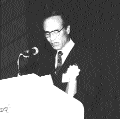Greeting

| Takashi Kitaoka President of the Real World Computing Partnership |

| Takashi Kitaoka President of the Real World Computing Partnership |
First of all, I would like to thank all of you for participating in the 1997 Real World Computing Symposium. In addition to a number of visitors from all over the world, it is our great pleasure to welcome Mr. Katsuhiro Nakagawa, Director General of the Machinery and Information Industries Bureau, Ministry of International Trade and Industry (MITI), and many special guests and speakers to this program.
In 1992, the Real World Computing Program started its research and development in cooperation with other related institutes at the request of MITI. This is an important, long-ranged project of a grand scale, designed to develop a new information technology paradigm, and provide breakthroughs of information technology to the world.
I believe that the Real World Computing Project is a highly challenging initiative. gChallengehis the keyword here; not only in the research and development areas but also in our business and industrial activities. Therefore, I would like to encourage all the researchers engaged in this project to accept and enjoy this challenge and to strive to produce successful results.
The first half of the Project has now been completed and we have called this symposium to present the project's achievements to date, and provide a forum for scientific discussion.
Found in the symposium's program are a number of demonstrations that will show how certain systems work. These include the integration of speech and gestures using a PC, and a system which can recognize human faces and voices. Your opinions and impressions concerning them will be highly appreciated.
I hope that further development of these research results will become highly advanced technologies such as computers which can dialogue with humans directly utilizing the natural languages, and information systems capable of accurately and quickly obtaining the overall picture of any large-scale social phenomena. Once achieved, these systems are sure to become the de facto standards all over the world.
The Real World Computing Project will enter its second phase, called thegNext Generation Fundamental Information Technology Project,hfrom April, 1997. This new phase will hopefully provide even greater achievements. The basic policy of the second phase will be introduced during this symposium.
I would like to thank many people and groups for their assistance and advice in organizing this symposium. In particular, we appreciate the help and cooperation of Professor Hidehiko Tanaka of the University of Tokyo, the Ministry of International Trade and Industry, and the Electrotechnical Laboratory of the Agency of Industrial Science and Technology of MITI.
Finally, it is my hope that the efforts towards technological development will be constantly undertaken to help the advancement of the information society in the 21st century.